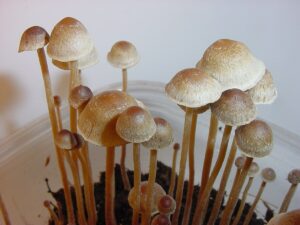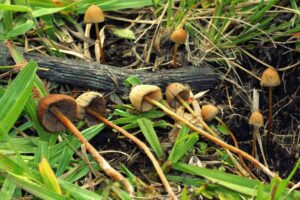Psilocybin mushrooms, often referred to as “magic mushrooms,” have captured the human imagination for centuries due to their psychedelic properties and potential for profound experiences. While they are commonly associated with their active compound, psilocybin, there are various species of psilocybin mushrooms, each with its unique characteristics. In this comprehensive guide, we will delve into the world of psilocybin mushroom varieties, exploring their differences, effects, and where they can be found.
The Psilocybin Experience: A Brief Overview
Before we dive into the specifics of different psilocybin mushroom species, let’s briefly discuss what the psilocybin experience entails. Psilocybin is a naturally occurring psychedelic compound found in certain mushrooms, primarily in the Psilocybe genus. When ingested, psilocybin is converted into psilocin, which interacts with serotonin receptors in the brain, leading to altered perception, heightened sensory experiences, and often profound insights.
The effects of psilocybin mushrooms can vary widely from person to person and are influenced by factors such as dosage, set (the individual’s mindset), and setting (the physical and social environment). Now, let’s embark on a journey to explore the fascinating diversity of psilocybin mushroom species.
1. Psilocybe cubensis
Common Names: Cubensis, Gold Cap, Golden Teacher
Habitat: Psilocybe cubensis is among the most widely distributed and easily recognizable psilocybin mushrooms. It is often found in tropical and subtropical regions, favoring dung-rich pastures and cow fields.
Appearance: The cap of P. cubensis is typically convex and can reach up to 8 cm in diameter. It is golden to caramel in color, often with a distinct white or pale yellow rim. The stem is slender, white, and may have remnants of a partial veil.
Effect: Psilocybe cubensis is known for producing intense and introspective experiences. It’s a favorite among beginners and experienced psychonauts alike due to its relatively mild potency.
2. Psilocybe semilanceata
Common Names: Liberty Cap, Magic Cap
Habitat: Psilocybe semilanceata is commonly found in Europe and North America. It prefers damp, grassy meadows and pastures.
Appearance: These mushrooms are small and delicate, with a bell-shaped cap that is conical when young but flattens with age. The cap is usually brown to tan with a distinctive pointed tip. The stem is slender and pale.
Effect: Liberty caps are known for their potent effects. They often induce a sense of euphoria, enhanced creativity, and a deep connection with nature.
3. Psilocybe cyanescens
Common Names: Wavy Cap, Blue Bottle, Halucinogenic Mushroom
Habitat: Psilocybe cyanescens is often found in wood chips, mulched gardens, and forested areas of North America, Europe, and New Zealand.
Appearance: These mushrooms have a distinct wavy cap, which is chestnut to caramel in color. The stem is white, thick, and may exhibit bluish bruising when touched.
Effect: Psilocybe cyanescens is renowned for its high psilocybin content. It can induce powerful visual hallucinations and intense emotional experiences.

4. Psilocybe azurescens
Common Names: Flying Saucer Mushroom
Habitat: Psilocybe azurescens is native to the Pacific Northwest of the United States. It is often found in coastal dune grasses and wood chips.
Appearance: These mushrooms have a convex to conical cap with a caramel to chestnut color. The stem is thick and whitish, with a slightly bulbous base.
Effect: Psilocybe azurescens is considered one of the most potent psilocybin mushrooms. It can produce intense and long-lasting trips with profound visual distortions.
Also Read : What Are the Strongest Magic Mushrooms?
5. Psilocybe tampanensis
Common Names: Philosopher’s Stone, Tampanensis
Habitat: Psilocybe tampanensis is not commonly found in the wild. It is often cultivated indoors, making it one of the few psilocybin mushrooms that can be legally grown in some regions.
Appearance: The mushrooms have a conical to bell-shaped cap with a chestnut-brown color. The stem is slender and often curved.
Effect: Psilocybe tampanensis is known for its euphoric and philosophical effects. It can lead to deep introspection and feelings of unity with the universe.

6. Psilocybe baeocystis
Common Names: Bottle Cap, Blue Bell
Habitat: Psilocybe baeocystis is found in North America, particularly in the Pacific Northwest. It grows in wood chips, mulch, and forested areas.
Appearance: These mushrooms have a bell-shaped cap that is brown to caramel in color. The stem is slender and often features bluish bruising.
Effect: Psilocybe baeocystis is known for its balanced and moderate psychedelic effects. It can induce a sense of introspection and heightened sensory perception.
7. Psilocybe mexicana
Common Names: Teonanácatl, Flesh of the Gods
Habitat: Psilocybe mexicana is native to Mexico and Central America. It grows in grassy and damp areas.
Appearance: These mushrooms have a conical cap with a brown to caramel color. The stem is slender and often curved. Psilocybe mexicana is historically significant as it was used in indigenous ceremonies by the Aztecs.
Effect: This species is associated with mystical and spiritual experiences. It can induce vivid visions and a profound sense of connection to the divine.

Conclusion
Exploring the various species of psilocybin mushrooms reveals a diverse world of fungi, each with its unique appearance, habitat, and effects. While these mushrooms have been used for centuries in spiritual and cultural contexts, it’s essential to approach them with caution and respect, understanding that the experiences they offer can vary widely.
If you’re considering consuming psilocybin mushrooms, it’s crucial to research the specific species, understand the potential risks, and ensure you are in a safe and supportive environment. Additionally, be aware of the legal status of psilocybin in your region, as it varies from place to place.
Ultimately, the world of psilocybin mushrooms is a testament to the incredible diversity of nature and the profound effects that these fungi can have on human consciousness

Hi! I’m Jacob Hawthorne, a passionate medical student dedicated to exploring the fascinating world of psychedelics, particularly magic mushrooms (commonly known as shrooms). With a deep interest in their therapeutic potential and profound effects on the human mind, I aim to provide accurate and evidence-based information about shrooms in the Canadian context.

